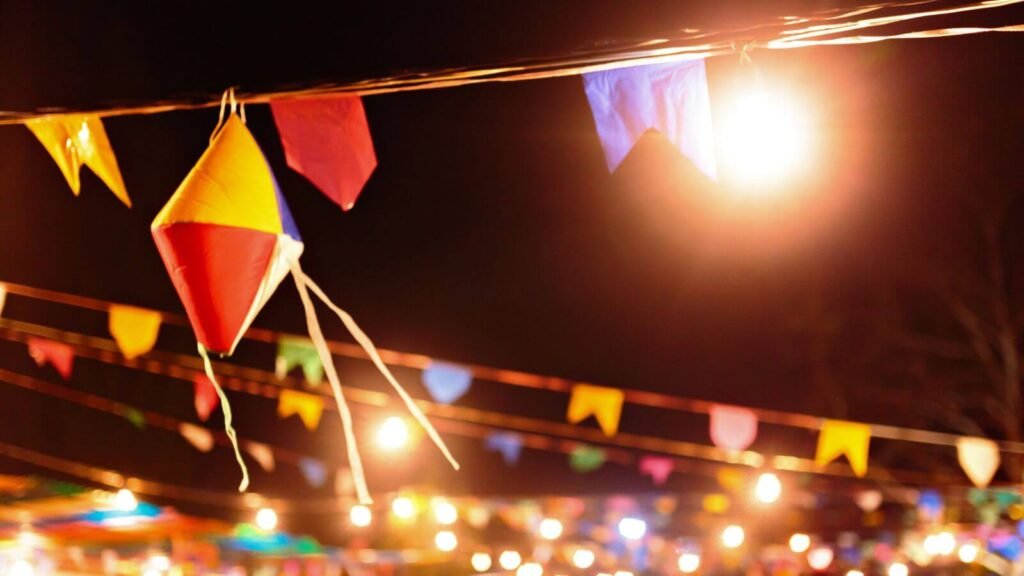Brazilian Festa Junina takes center stage as a vibrant and cherished celebration that captures the heart of Brazil, stepping aside from the spotlight of Carnival. Imagine a kaleidoscope of colors, the irresistible aroma of corn-based delicacies and spiced mulled wine, the contagious rhythms of forró music, and entire communities coming together in a joyful explosion of rural charm. This month-long (and sometimes longer!) series of festivities transforms Brazil into a giant, welcoming “arraial” (a traditional fair or camp).
For travelers from the USA, Europe, or anywhere else in the world, experiencing Festa Junina is to dive headfirst into an authentic slice of Brazilian culture that is as heartwarming as it is exhilarating. It’s a celebration steeped in history, rich in tradition, and bursting with unique flavors and sounds.
What is Festa Junina? Unpacking Brazil’s Beloved June Festival
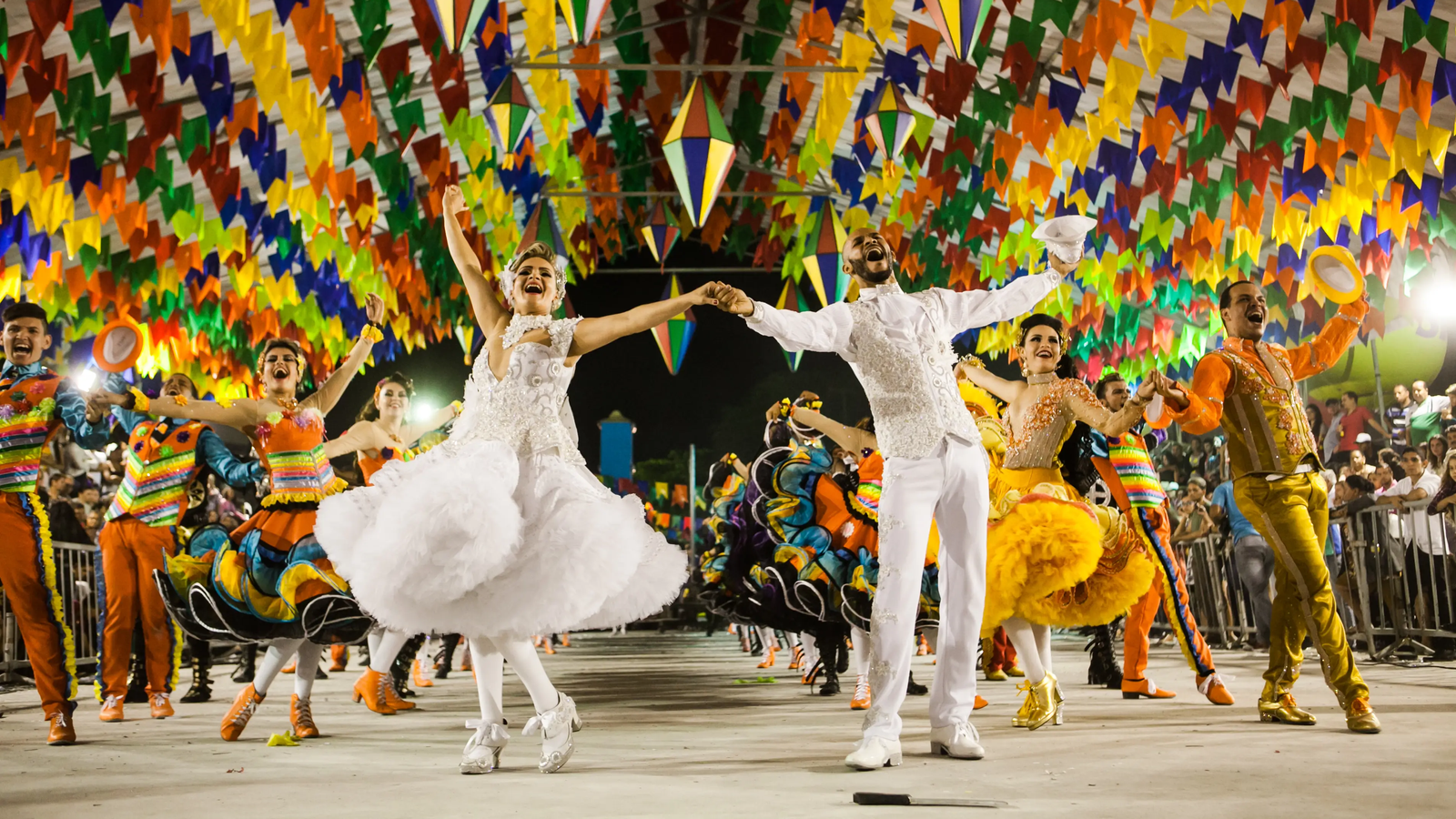
Festa Junina, at its core, is a vibrant tapestry woven from diverse threads: ancient European harvest rituals, Catholic saintly devotion, and the rich, earthy tones of Brazilian rural life. It’s a celebration that resonates deeply within the Brazilian soul, marking a time of thanksgiving, community, and joyous revelry.
A Sweet Mix of Harvest, Saints, and Country Charm
The origins of Festa Junina are fascinatingly complex. Its earliest roots can be traced back to European pagan festivals celebrating the summer solstice and the abundance of the harvest. With the spread of Christianity, these traditions were gradually assimilated and linked to the feast days of three key Catholic saints in June: Saint Anthony (Santo Antônio) on June 13th, known as the marriage saint; Saint John the Baptist (São João Batista) on June 24th, the central figure of the celebrations, often associated with bonfires; and Saint Peter (São Pedro) on June 29th, considered the guardian of fishermen and heavenly gatekeeper.
When Portuguese colonizers arrived in Brazil from the 16th century onwards, they brought these June festivities with them. Over centuries, these European customs beautifully melded with indigenous Brazilian traditions and, later, influences from Afro-Brazilian culture. The result is a uniquely Brazilian celebration that, while honoring its religious roots, primarily celebrates rural life (vida caipira), the agricultural harvest (especially corn, which is in abundance), and the end of the rainy season in many parts of the country. The timing is perfect, as June falls during Brazil’s winter, making the bonfires and warm, spiced drinks all the more inviting.
More Than Just a Party: The Cultural Heartbeat of Festa Junina
Festa Junina is far more than just a collection of parties; it’s a significant cultural phenomenon that pulsates throughout Brazil. While its spirit is national, the way it’s celebrated can vary wonderfully from region to region, each adding its unique local flavor.
The Northeast of Brazil is undoubtedly the epicenter of Festa Junina. Cities like Campina Grande in Paraíba and Caruaru in Pernambuco host colossal month-long events, famously competing for the title of “O Maior São João do Mundo” (The Biggest Saint John’s Festival in the World). These are mega-festivals attracting millions with enormous stages for musical acts, gigantic quadrilha dance performances, and an electrifying atmosphere. Other Northeastern states, such as Bahia, Sergipe, and Rio Grande do Norte, also boast vibrant and traditional celebrations, often featuring unique folk expressions like the Bumba Meu Boi in Maranhão.
In the Southeast, including major cities like São Paulo, Rio de Janeiro, and Belo Horizonte, Festa Junina is widely celebrated in schools, churches (through lively fairs called “quermesses”), clubs, and private gatherings. While perhaps more urbanized, these events faithfully recreate the traditional ambiance with typical foods, dances, and attire. The cooler June weather in this region makes traditional hot drinks like quentão (mulled cachaça) and vinho quente (mulled wine) especially popular.
The South of Brazil, with its strong European immigrant heritage, also embraces Festa Junina, sometimes blending it with its own cultural traditions. Pinhão (cooked pine nuts from the Araucaria tree) becomes a seasonal Festa Junina staple here. Further north and in the Central-West, the celebrations continue, often incorporating local elements from the Amazon or Cerrado biomes. Regardless of the region, the common thread is the profound sense of community spirit. Festas Juninas are overwhelmingly family-friendly, inclusive, and foster a warm, welcoming environment where people come together to celebrate their shared culture and heritage with a palpable sense of joy and nostalgia.
The Sights, Sounds, and Smells: Key Elements of Festa Junina
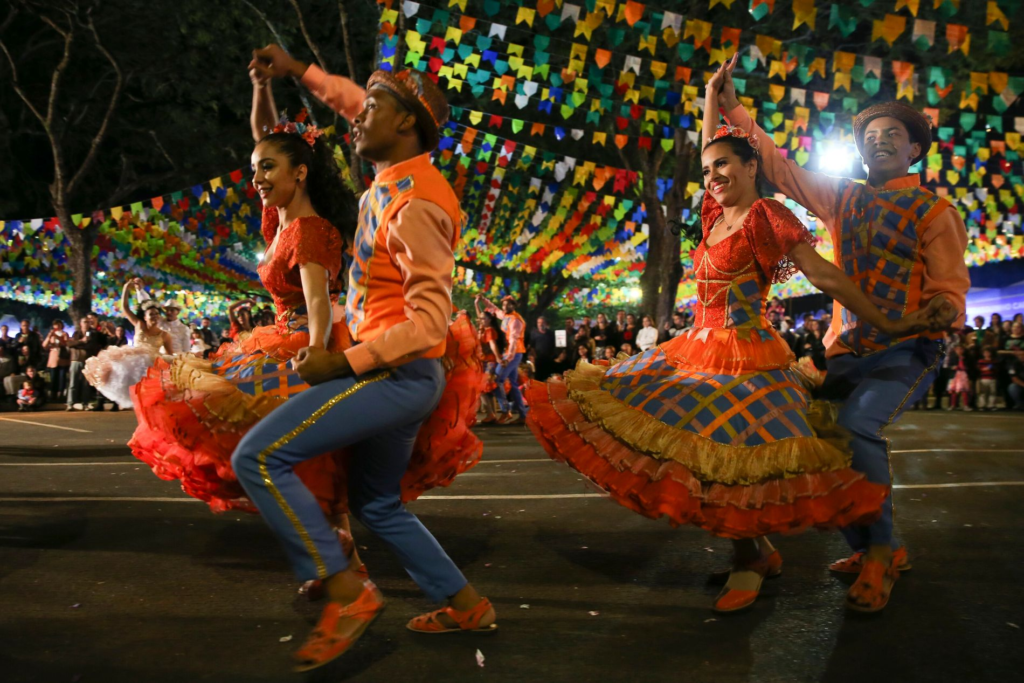
A true Festa Junina is an immersive experience that tantalizes all the senses. From the distinctive rustic attire and colorful decorations to the unique rhythms of its music and the joyous shouts from traditional games, every element contributes to an unforgettable atmosphere.
Dressing the Part: Traje Caipira (Country Attire)
One of the most delightful aspects of Festa Junina is the tradition of dressing up in “traje caipira,” or country-style clothing. This isn’t about high fashion; it’s about embracing a playful, somewhat caricatured version of rural Brazilian attire from bygone days. For men, this typically means plaid shirts (camisa xadrez), jeans often adorned with colorful patches (retalhos), a straw hat (chapéu de palha), and perhaps a neckerchief (lenço no pescoço). To complete the look, some might draw on a unibrow, a few missing teeth, or a scruffy beard.
Women and girls often wear brightly colored, ruffled dresses, frequently made from “chita” (a type of chintz fabric with floral patterns), adorned with lace and ribbons. Pigtails (maria-chiquinha) tied with ribbons, a decorated straw hat, and charmingly painted freckles on the cheeks are classic touches. The overall effect is one of rustic charm and lighthearted fun.
Tips for Foreigners: Don’t be shy – joining in with the traje caipira is highly encouraged and a fantastic way to immerse yourself in the spirit of the festival! You don’t need an elaborate costume. A simple plaid shirt and jeans will do for men, and a colorful dress or skirt for women. Straw hats are inexpensive and widely available in Brazil during June. Many stores will also sell specific Festa Junina accessories. The key is to have fun with it!
Deck the Halls: Festive Decorations (Bandeirinhas and Balões)
The visual identity of Festa Junina is instantly recognizable thanks to its unique decorations. The most iconic are the “bandeirinhas” – countless small, colorful paper flags strung together in long rows, creating a vibrant canopy over the arraial. These simple flags transform any space into a festive wonderland.
“Balões” (lanterns), traditionally made of colorful paper, also feature prominently. While actual fire balloons (which are released into the sky) are now largely discouraged or illegal in many places due to fire hazards, decorative paper lanterns of various shapes and sizes are still used to enhance the festive atmosphere. Bonfires (“fogueiras”) are another crucial element, especially on the eve of Saint John’s Day (June 23rd).
The bonfire is a powerful symbol of warmth, purification, and community gathering. Different saints are sometimes honored with bonfires of specific shapes – square for St. Anthony, round for St. John, and triangular for St. Peter. Other decorative touches include straw, hay bales, corn stalks, and rustic wooden structures, all contributing to the rural, country fair ambiance.
The Soundtrack of the Arraial: Forró and Sertanejo Music
Music is the lifeblood of Festa Junina, and two genres reign supreme: forró and sertanejo. Forró is the quintessential sound of the June festivals, especially in its Northeastern heartland. This lively, danceable music is traditionally played by a trio of instruments: the accordion (sanfona), the zabumba (a type of flat, double-headed bass drum), and the triangle. The contagious rhythms of forró are guaranteed to get your feet tapping. Legendary artists like Luiz Gonzaga, the “King of Baião” (a rhythm within forró), and Dominguinhos have immortalized this genre.
Sertanejo, Brazil’s version of country music, is also incredibly popular at Festas Juninas across the nation. This includes both traditional “sertanejo de raiz” (roots country music) and the more contemporary, pop-influenced “sertanejo universitário” (university country music). Whether it’s a live band playing beloved classics or a DJ spinning modern hits, the music creates an energetic and joyful atmosphere that is central to the Festa Junina experience.
Let’s Dance! The Quadrilha Junina (Folk Dance)
No Festa Junina is complete without the Quadrilha Junina. This traditional folk dance is a vibrant and entertaining spectacle, similar in style to European square dancing or American contra dance. Colorfully dressed couples (in full traje caipira) dance in formations, executing a series of steps and movements dictated by a “marcador” (caller). The marcador doesn’t just call out dance moves; they often narrate a humorous story, typically centered around a mock countryside wedding, the “casamento caipira.” This storyline involves characters like the bride and groom (often a pregnant bride and a reluctant groom), the priest, the sheriff, and the bride’s protective father, leading to much comedic drama and audience participation.
Quadrilhas can range from informal, spontaneous dances at smaller parties to highly elaborate, competitive performances by professional or dedicated community groups, especially at the large festivals in the Northeast. Watching a well-rehearsed quadrilha is a true highlight, showcasing intricate choreography, dazzling costumes, and infectious energy. While the complex group dances might seem daunting, don’t be surprised if you’re pulled into a more casual quadrilha at a local quermesse – it’s all part of the fun!
Fun and Games: Traditional Festa Junina Activities
Beyond the music and dancing, Festas Juninas are filled with an array of traditional games and activities that delight both children and adults. These games, often simple and charmingly rustic, contribute to the fair-like atmosphere of the arraial:
- Pescaria (Fishing Game): Participants use a toy fishing rod to try and “catch” wrapped prizes or numbered fish corresponding to prizes.
- Correio Elegante (Elegant Mail): A beloved tradition where people can send anonymous (or signed) romantic notes, compliments, or friendly messages to others at the party. These messages are written on colorful paper and delivered by a designated “mailperson,” often leading to blushes and laughter.
- Pau de Sebo (Greasy Pole): A tall wooden pole, thoroughly greased, with a prize (often money or a valuable item) at the very top. Brave (and agile) participants attempt to climb the slippery pole to claim the reward, usually with much slipping, sliding, and cheering from the crowd.
- Argola (Ring Toss): Tossing rings to try and land them around the necks of bottles or over other targets to win a prize.
- Boca do Palhaço (Clown’s Mouth): Throwing balls to try and get them into a large cutout of a clown’s mouth.
- Bingo: A staple at many quermesses, with participants eagerly listening for numbers to be called out to win various prizes.
- Tomba Lata (Can Knockdown): Throwing balls to knock down a pyramid of cans.
These games, along with the ever-present bonfires, create a lively and interactive environment where everyone can participate and share in the simple joys of the celebration.
A Feast for the Senses: Must-Try Festa Junina Foods and Drinks
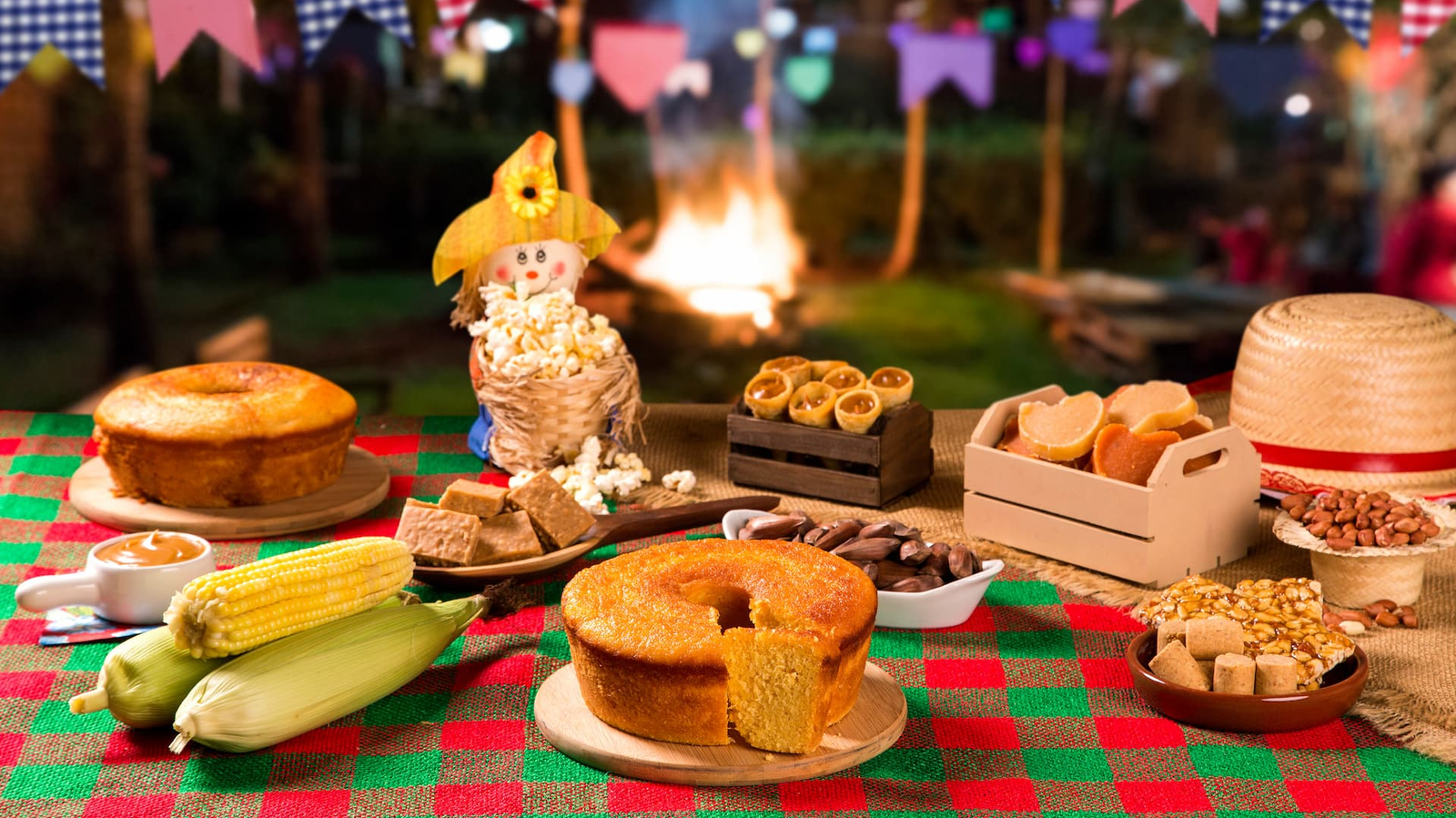
No Brazilian celebration is complete without an abundance of delicious food, and Festa Junina is certainly no exception! The culinary landscape of these June festivals is rich, rustic, and heavily influenced by the harvest season, with corn taking center stage. Prepare your taste buds for a delightful journey through sweet and savory treats, and warming traditional drinks.
Corn, Corn, Everywhere! The Star Ingredient
Corn (milho) is the undisputed king of Festa Junina cuisine, appearing in a myriad of creative and mouthwatering forms:
- Pamonha: A beloved classic, pamonha is a paste made from fresh, grated sweet corn, often mixed with coconut milk and sugar for a sweet version, or with salt and sometimes cheese for a savory one (though the sweet version is more common at festivals). This mixture is then wrapped in corn husks and boiled until firm. It’s a comforting and iconic Festa Junina treat.
- Curau / Canjica (Northeastern term for Curau): This is a creamy, sweet corn pudding made from the juice of fresh corn, cooked with milk, sugar, and a sprinkle of cinnamon on top. Its smooth texture and sweet flavor make it a popular dessert. (Note: The term “canjica” can be confusing, as in the Southeast and South of Brazil, it refers to a different dish made with white hominy corn – see below).
- Milho Cozido (Boiled Corn on the Cob): Simple, yet always a favorite. Fresh corn on the cob, boiled to perfection and often served with a generous spread of butter and a pinch of salt.
- Bolo de Milho / Bolo de Fubá (Cornmeal Cake): These rustic cakes, made from cornmeal (fubá) or fresh corn, come in various textures, from light and fluffy to dense and moist. They are perfect with a cup of coffee or quentão.
- Pipoca (Popcorn): A universal festival snack, popcorn is a must-have at any Festa Junina. You’ll find both savory (salted) and sweet (caramelized or chocolate-coated) versions.
- Cuscuz Nordestino (Northeastern Couscous): A steamed cornmeal dish that can be served sweet (with coconut milk and sugar) or savory (with butter, cheese, sausage, or dried meat – carne seca). It’s a hearty and versatile option.
Sweet Treats to Indulge In
Beyond corn, Festa Junina boasts an array of traditional sweets that will satisfy any sugar craving:
- Pé-de-moleque (Peanut Brittle): Literally meaning “urchin’s foot” (due to its lumpy appearance), this is a crunchy candy made from roasted peanuts and rapadura (unrefined cane sugar) or molasses.
- Paçoca (Peanut Candy): A crumbly, sweet delight made from ground roasted peanuts, sugar, and often a bit of cassava flour or cornmeal to bind it.
- Cocada (Coconut Candy): A chewy or crunchy candy made primarily from shredded coconut and sugar. It comes in various styles: white (traditional), brown or “queimada” (with burnt sugar for a caramel flavor), or creamy (with condensed milk).
- Arroz Doce (Rice Pudding): A comforting classic, rice cooked slowly with milk, sugar, and spices like cinnamon and cloves, sometimes with a hint of lemon zest.
- Bolo de Mandioca (Cassava Cake): A moist, dense, and often gluten-free cake made from grated cassava (manioc/yuca), coconut milk, and sugar.
- Maçã do Amor (Candy Apple/Toffee Apple): A bright red, glossy candy apple that is a nostalgic treat for many Brazilians.
- Doce de Abóbora (Pumpkin Preserve): A sweet, spiced pumpkin preserve, often made with coconut flakes.
- Doce de Batata Doce (Sweet Potato Preserve): Similar to the pumpkin preserve, this is a sweet, dense treat made from sweet potatoes.
- Canjica (Southeastern/Southern term) / Mungunzá (Northeastern term): This is a different dish from the corn pudding mentioned earlier. It’s made from white hominy corn (milho branco) cooked slowly with milk, coconut milk, sugar, cinnamon, and cloves until tender and creamy. A truly heartwarming dessert.
Savory Delights and Hearty Dishes
To balance out the sweetness, there are plenty of savory options to enjoy:
- Caldo Verde (Green Broth): Especially popular in the cooler southern and southeastern regions, this is a hearty Portuguese-inspired soup made with potatoes, finely shredded collard greens, and slices of paio or linguiça sausage.
- Caldo de Feijão (Bean Broth): A rich and flavorful bean broth, often seasoned with bacon, garlic, onions, and herbs. Perfect for a chilly June evening.
- Espetinhos (Barbecue Skewers): Grilled skewers of beef, chicken, linguiça sausage, or even queijo coalho (a firm, salty cheese that grills beautifully).
- Pastel (Fried Pastry): Thin, crispy fried pastries filled with various savory ingredients like cheese, minced meat, chicken with catupiry cheese, or heart of palm.
- Pinhão Cozido (Boiled Pine Nuts): A seasonal treat in the South of Brazil, these large pine nuts from the Araucaria tree are boiled in salted water and eaten warm.
- Salsichão (Large Sausage): Grilled or boiled large sausages, often served in a bread roll or on their own.
Warming Drinks for Cool June Nights
The cool evenings of Brazilian winter (June-August) call for warming traditional drinks:
- Quentão (Hot Stuff): The quintessential Festa Junina alcoholic beverage. Its name literally means “very hot” or “big hot one.” Traditionally made with cachaça (Brazilian sugarcane spirit), ginger, cloves, cinnamon, sugar, and sometimes pieces of fruit like orange or apple peels, all simmered together. Non-alcoholic versions, often made with grape juice or apple juice and spices, are usually available for children and those who prefer not to drink alcohol.
- Vinho Quente (Mulled Wine): Similar to European mulled wine, this is hot red wine sweetened with sugar and spiced with cinnamon, cloves, and pieces of apple or orange.
- Chocolate Quente (Hot Chocolate): A universally loved warm drink, perfect for all ages.
Quick Food & Drink Guide Table
| Item | Type | Brief Description |
|---|---|---|
| Pamonha | Sweet/Savory (Corn) | Sweet corn paste boiled in husks |
| Curau/Canjica (NE) | Sweet (Corn) | Creamy sweet corn pudding |
| Milho Cozido | Savory (Corn) | Boiled corn on the cob |
| Bolo de Milho/Fubá | Sweet (Corn) | Cornmeal cake |
| Pé-de-moleque | Sweet (Peanut) | Peanut brittle |
| Paçoca | Sweet (Peanut) | Crumbly peanut candy |
| Cocada | Sweet (Coconut) | Coconut candy |
| Arroz Doce | Sweet (Rice) | Rice pudding |
| Caldo Verde | Savory (Soup) | Green broth with potato and sausage |
| Quentão | Drink (Alcoholic/Non) | Hot mulled cachaça or spiced juice |
| Vinho Quente | Drink (Alcoholic) | Mulled red wine |
Celebrating Festa Junina as a Foreigner: Your Survival Guide
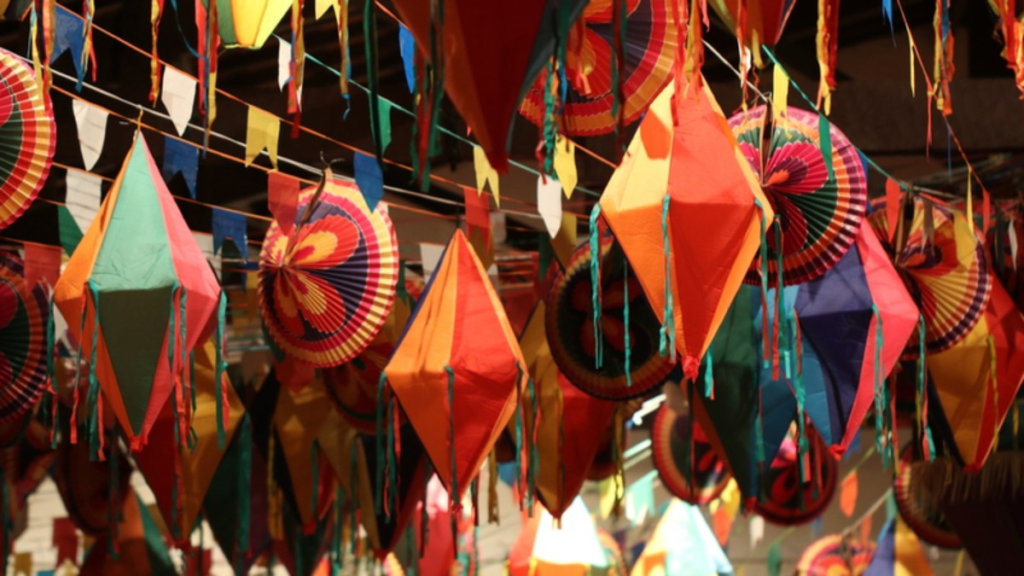
Experiencing Festa Junina as a foreigner can be an incredibly rewarding cultural immersion. Brazilians are generally very welcoming, and the festive atmosphere makes it easy to join in the fun. Here’s how to make the most of it:
Where to Experience Authentic Festa Junina
You can find Festa Junina celebrations all over Brazil, but the scale and style can vary:
- Mega-Festivals (Northeast): For the most grandiose and intense experience, head to cities like Campina Grande (Paraíba) or Caruaru (Pernambuco). These month-long events are legendary, featuring massive concerts with famous Brazilian artists, enormous quadrilha competitions, and a non-stop party atmosphere. Be sure to book flights and accommodation many months in advance, as these are major tourist destinations in June.
- Community “Arraiais” or “Quermesses”: For a more local and often more intimate experience, look for celebrations organized by churches, schools, local clubs, or neighborhood associations. These are common in cities across Brazil, including São Paulo, Rio de Janeiro, Belo Horizonte, and Curitiba. They offer a wonderful opportunity to mingle with locals and experience traditions up close. Check local event listings online (city tourism sites, local news portals, Facebook events) or simply ask your hotel staff or local friends for recommendations.
- Specific Venues: Some cultural centers, parks, or even shopping malls in larger cities might host their own Festa Junina events, often with a good mix of traditional elements and modern conveniences.
Embracing the Caipira Spirit: Dos and Don’ts
- DO: Dress up! Even a simple plaid shirt or a straw hat will show you’re embracing the spirit.
- DO: Try as much of the food and drink as you can. Be adventurous!
- DO: Attempt a few forró steps if there’s dancing, or join in if a casual quadrilha forms. Enthusiasm trumps skill!
- DO: Be open, friendly, and try to interact with locals. A smile goes a long way.
- DO: Participate in the games – they’re cheap and fun.
- DON’T: Be afraid to ask questions about the traditions, food, or dances. Brazilians are usually happy to explain.
- DON’T: Worry about not knowing everything or not being perfectly dressed. The emphasis is on fun and participation.
- DON’T: Be disrespectful of any religious symbols or moments if the event is at a church quermesse.
Navigating the Arraial: Practical Tips
- Cash is King: While card payments are becoming more common, many smaller food stalls and game vendors at community events might prefer cash (Brazilian Reais – R$). It’s wise to have some smaller notes on hand.
- Safety First: As with any crowded public event, be mindful of your belongings. Keep valuables secure and be aware of your surroundings. Generally, Festas Juninas are family-friendly and safe, but it’s always good to be cautious.
- Language Basics: While you might find English speakers, especially at larger tourist-oriented events, knowing a few basic Portuguese phrases will be very helpful and appreciated:
- “Quanto custa?” (KWAN-too KOOS-tah?) – How much does it cost?
- “Eu gostaria de…” (Eh-oo gos-tah-REE-ah jee…) – I would like…
- “Um/Uma, por favor.” (Oom/OO-mah, por fah-VOR) – One, please.
- “Obrigado” (oh-bree-GAH-doo) if you are male / “Obrigada” (oh-bree-GAH-dah) if you are female – Thank you.
- “Delicioso!” (deh-lee-see-OH-zoo) – Delicious!
- Best Time to Go: Evenings (after 6 PM) and weekends are typically when Festas Juninas are at their liveliest, with more people, music, and activities in full swing.
- Comfortable Shoes: You’ll likely be doing a lot of standing, walking, and perhaps dancing, so comfortable footwear is essential.
Understanding Costs: What to Budget For (in USD)
Festa Junina can be a very affordable cultural experience:
- Entrance Fees: Many community quermesses and street arraiais are free to enter or have a nominal entrance fee (e.g., $1 – $5 USD, sometimes redeemable for a small food item or game). The large festivals in the Northeast might have free general access to the main festival grounds, but specific concerts or shows within the area could be ticketed separately.
- Food and Drinks: Individual food items (like pamonha, milho cozido, bolo de milho, espetinhos) typically range from $1 to $5 USD. Drinks like quentão or vinho quente might be $2 to $4 USD.
- Games and Activities: Most traditional games are very inexpensive, often costing around $0.50 to $2 USD per try.
Overall, a foreigner could comfortably enjoy an evening at a local Festa Junina, sampling various foods, drinks, and playing a few games, for around $15 to $30 USD, excluding transportation to the event or significant souvenir purchases.
Beyond the Party: The Enduring Legacy of Festa Junina
Festa Junina is more than just a month of parties; it plays a vital role in preserving and celebrating Brazilian cultural heritage. It’s a living tradition that connects generations, reinforces community bonds, and showcases the rich tapestry of Brazil’s rural roots and folk customs. The festivals also have a significant economic impact, particularly in the Northeast, boosting tourism, creating temporary jobs, and providing a platform for local artisans, food producers, and musicians to showcase their talents and products.
While deeply rooted in history, Festa Junina is not a static tradition. It continues to evolve, with modern musical acts sharing stages with traditional forró bands at large festivals, and contemporary interpretations of classic dishes appearing alongside time-honored recipes. Yet, despite these modern touches, the core spirit of Festa Junina – its warmth, its joy, its celebration of community and simple pleasures – endures, making it one of Brazil’s most beloved and authentic cultural expressions.
Conclusion: Get Ready to Fall in Love with Brazil’s Festa Junina!
Festa Junina is a truly magical and uniquely Brazilian experience. It’s a vibrant explosion of color, flavor, music, and dance that offers a heartwarming glimpse into the country’s rich cultural heritage and its deep connection to rural traditions. From the charmingly rustic attire and lively quadrilha dances to the mouthwatering array of corn-based delicacies and spiced winter drinks, every aspect of Festa Junina is designed to delight the senses and foster a spirit of joyful community.
For any foreigner visiting Brazil during June (or even July!), seeking out a Festa Junina celebration is an absolute must. Whether you find yourself at a massive São João festival in the Northeast or a cozy neighborhood quermesse in the Southeast, you’re guaranteed an authentic, engaging, and unforgettable cultural immersion. So, dust off your (imaginary or real) straw hat, practice your best “anarriê!” (a quadrilha call), and get ready to fall in love with the enchanting world of Festa Junina. You might just find it’s your new favorite Brazilian party!
Have you ever experienced a Festa Junina in Brazil? What were your favorite parts? Or do you have any questions about celebrating it as a foreigner? Share your thoughts and queries in the comments below!
